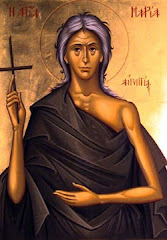Synodal Piety
"And the cathedrals -- the crowning expression of the synodal architectural craftsmanship -- were overwhelming in their massiveness, their spaciousness, their gilt and marble, with huge cupolas, resonant echoes, immense royal doors and costly vestments. Colossal choirs performed special Italianate and secularized ecclesiastical chants. The images on the icons could hardly be seen, having been encased in gold and silver covers. The deacon could hardly lift the book of the Gospels, with its heavy binding, and he read it in such a way that at times it was impossible to understand a single word. But it was not his job to make the reading understandable: he had to begin with a kind of unimaginably low rumble and end in a window-rattling bellow, showing off the mighty power of his voice. Everything had but a single purpose, everything was in harmony with each aspect of the epoch's churchmanship, everything had as its aim a display of the power, wealth, and indestructibility of the Orthodox Church and the great Russian State which protected her.
..."Here everything is channeled toward conservation, to the preservation of the foundations, to the repetition of feelings, words and gestures. Creativity demands some new kind of challenge; here there was none, neither in the field of ideas, nor in the field of arts, nor in the way of life. Everything was strongly guarded and protected. Innovation was not permitted. There was no need for any creative principle. The synodal type of religious life, which promoted other values along with spiritual ones, namely those of the State, of a way of life and of a particular tradition, not only distorted and confused the hierarchy of values, but often simply replaced Christian love with an egotistical love for the things of this world. It is difficult, even impossible to see Christ, to experience a Christianization of life, where the principle of the secularization of the Church is openly proclaimed. This type of piety was not up to the difficult task of rendering to God what is God's and what is Caesar's to Caesar."
Ritualism
"Christ, who turned away from scribes and Pharisees, Christ, who approached prostitutes, publicans and sinners, can hardly be the Teacher of those who are afraid to soil their pristine garments, who are completely devoted to the letter, who live only by the rules, and who govern their whole life according to the rules. Such people consider themselves in good spiritual health because they observe everything that is prescribed by spiritual hygiene. But Christ told us, it is not the healthy who are in need of a physician, but the sick. In fact, we have today two citadels of such an Orthodoxy -- traditional, canon-based, patristic and paternal Orthodoxy: Athos and Valaam. A world of people far removed from our bustle and our sins, a world of faithful servants of Christ, a world of knowledge of God and contemplation.
And what do you suppose most upsets this world of sanctity? How does it regard the present calamities which are tearing us apart, the new teachings, heresies perhaps, the destitution, the destruction and the persecution of the Church, the martyrs in Russia, the trampling down of belief throughout the whole world, the lack of love? Is this what most alarms these islands of the elect, these pinnacles of the Orthodox spirit? Not at all. What strikes them as the most important, the most vital, the most burning issue of the day, is the question of the use of the Old or New Style Calendar in divine services. It is this that splits them into factions, this that leads them to condemn those who think other than they do, this that defines their measure of things."
Aesthetic Piety"The eyes of love will perhaps be able to see how Christ himself departs, quietly and invisibly, from the sanctuary which is protected by a splendid iconostasis. The singing will continue to resound, clouds of incense will still rise, the faithful will be overcome by the ecstatic beauty of the services. But Christ will go out on to the porch and mingle with the crowd: the poor, the lepers, the desperate, the embittered, the holy fools. Christ will go out into the streets, the prisons, the hospitals, the low haunts and dives. Again and again Christ lays down his life for his friends.
What is our beauty and our ugliness in comparison with Christ, his eternal truth and eternal beauty? Does our beauty not look ugly when compared to his eternal beauty? Or, is it not the reverse? Does he not see in our ugliness, in our impoverished lives, in our festering sores, in our crippled souls -- does he not see there his own divine image and a reflection of his eternal glory and eternal beauty? And so he will return to the churches and bring with him all those whom he has summoned to the wedding feast, has gathered from the highways, the poor and the maimed, prostitutes and sinners."
Ascetic Piety"There is also another respect in which asceticism can cease to be a method for attaining higher spiritual values and become an end in itself. An individual may carry out one or another form of ascetic exercise not because it frees him from something or because it offers him something, but simply because it is challenging and demands an effort. It provides him nothing in the outer world, nor does it contribute anything to the content of his spiritual experience, nor does it advance him on his inner path. It is unpleasant for him to limit himself to one particular sphere -- so it is in the name of this unpleasantness that he must do this. The surmounting of an unpleasantness, as the only goal, exercise for the sake of exercise, is at best a working-out of a simple submission to disciplinary challenges and is, of course, a distortion of the ascetic path.
All of the above are mere trifles when compared with the fundamental conflict of world view which now characterizes Christianity. This conflict concerns the most essential, the most fundamental understanding of the goal of the Christian life and divides, as it were, the Christian world into two basic points of view. I am speaking here of the salvation of the soul."
and finally: The Evangelical Path"What is most characteristic of this path? It is a desire to "Christify" all of life. To a certain degree this notion can be contrasted to that which is understood not only by the term "enchurchment," but also the term "Christianization." "Enchurchment" is often taken to mean the placing of life within the framework of a certain rhythm of church piety, the subordination of one's personal life experience to the schedule of the cycle of divine services, the incorporation of certain specific elements of "churchliness" into one's way of life, even elements of the Church's ustav. "Christianization," however, is generally understood as nothing more than the correction of the bestial cruelty of man's history through inoculation with a certain dose of Christian morality. And in addition to this it also includes the preaching of the Gospel to the whole world.
"Christification," however, is based on the words, "It is no longer I who live, but Christ who lives in me" (Gal. 2:20). The image of God, the icon of Christ, which truly is my real and actual essence or being, is the only measure of all things, the only path or way which is given to me. Each movement of my soul, each approach to God, to other people, to the world, is determined by the suitability of that act for reflecting the image of God which is within me."
Read it all. The excerpts I've quoted here are NOT the most informative, provocative, and edifying passages by far, so take a look see!





